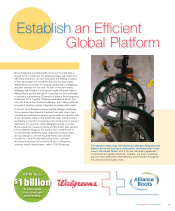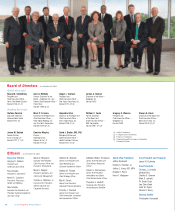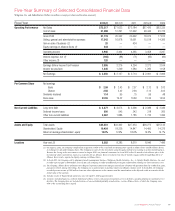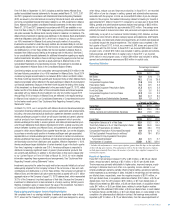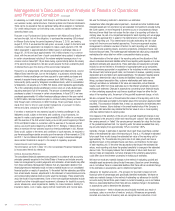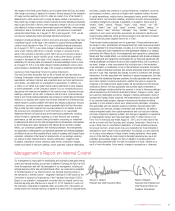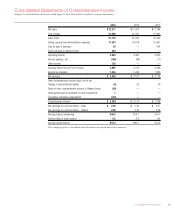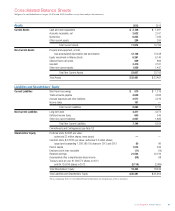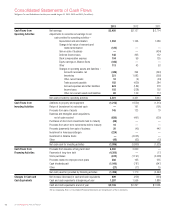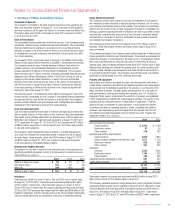Walgreens 2013 Annual Report Download - page 27
Download and view the complete annual report
Please find page 27 of the 2013 Walgreens annual report below. You can navigate through the pages in the report by either clicking on the pages listed below, or by using the keyword search tool below to find specific information within the annual report.
of sales when the related merchandise is sold. Those allowances received for
promoting vendors’ products are offset against advertising expense and result in a
reduction of selling, general and administrative expenses to the extent of advertising
incurred, with the excess treated as a reduction of inventory costs. We have not
made any material changes to the method of estimating our vendor allowances
during the last three years. Based on current knowledge, we do not believe there
is a reasonable likelihood that there will be a material change in the estimates or
assumptions used to determine vendor allowances.
Asset impairments – The impairment of long-lived assets is assessed based upon both
qualitative and quantitative factors, including years of operation and expected future
cash flows, and tested for impairment annually or whenever events or circumstances
indicate that a certain asset may be impaired. If the future cash flows reveal that the
carrying value of the asset group may not be recoverable, an impairment charge
is immediately recorded. We have not made any material changes to the method
of estimating our asset impairments during the last three years. Based on current
knowledge, we do not believe there is a reasonable likelihood that there will be a
material change in the estimates or assumptions used to determine asset impairments.
Liability for closed locations – The liability is based on the present value of future rent
obligations and other related costs (net of estimated sublease rent) to the first lease
option date. We have not made any material changes to the method of estimating
our liability for closed locations during the last three years. Based on current knowledge,
we do not believe there is a reasonable likelihood that there will be a material change
in the estimates or assumptions used to determine the liability.
Liability for insurance claims – The liability for insurance claims is recorded based on
estimates for claims incurred and is not discounted. The provisions are estimated in part
by considering historical claims experience, demographic factors and other actuarial
assumptions. We have not made any material changes to the method of estimating
our liability for insurance claims during the last three years. Based on current
knowledge, we do not believe there is a reasonable likelihood that there will be a
material change in the estimates or assumptions used to determine the liability.
Cost of sales – Drugstore cost of sales is derived based on point-of-sale scanning
information with an estimate for shrinkage and adjusted based on periodic inventory
counts. Inventories are valued at the lower of cost or market determined by the last-in,
first-out (LIFO) method. We have not made any material changes to the method
of estimating cost of sales during the last three years. Based on current knowledge,
we do not believe there is a reasonable likelihood that there will be a material change
in the estimates or assumptions used to determine cost of sales.
Equity method investments – We use the equity method to account for investments in
companies if the investment provides the ability to exercise significant influence, but
not control, over operating and financial policies of the investee. Our proportionate share
of the net income or loss of these companies is included in consolidated net earnings.
Judgment regarding the level of influence over each equity method investment
includes considering key factors such as our ownership interest, representation
on the board of directors, participation in policy-making decisions and material
intercompany transactions.
The underlying net assets of the Company’s equity method investment in Alliance Boots
include goodwill and indefinite-lived intangible assets. These assets are evaluated
for impairment annually, or more frequently if an event occurs or circumstances
change that would more likely than not reduce the fair value of a reporting unit
below its carrying value. Based on testing performed during fiscal 2013, the fair
value of each Alliance Boots reporting unit exceeded its carrying value. For certain
reporting units, relatively modest changes in key assumptions may have resulted in
the recognition of a goodwill impairment charge. The Company’s proportionate share
of a potential impairment would be limited to its 45% ownership percentage.
Income taxes – We are subject to routine income tax audits that occur periodically in
the normal course of business. U.S. federal, state, local and foreign tax authorities
raise questions regarding our tax filing positions, including the timing and amount of
deductions and the allocation of income among various tax jurisdictions. In evaluating
the tax benefits associated with our various tax filing positions, we record a tax benefit
for uncertain tax positions using the highest cumulative tax benefit that is more likely
than not to be realized. Adjustments are made to our liability for unrecognized tax
benefits in the period in which we determine the issue is effectively settled with the tax
authorities, the statute of limitations expires for the return containing the tax position or
when more information becomes available. Our liability for unrecognized tax benefits,
including accrued penalties and interest, is primarily included in other long-term
liabilities and current income taxes on our consolidated balance sheets and in income
tax expense in our consolidated statements of comprehensive income.
In determining our provision for income taxes, we use an annual effective income tax
rate based on full-year income, permanent differences between book and tax income,
and statutory income tax rates. The effective income tax rate also reflects our assess-
ment of the ultimate outcome of tax audits in addition to any foreign-based income
deemed to be taxable in the United States. Discrete events such as audit settlements
or changes in tax laws are recognized in the period in which they occur. Based on
current knowledge, we do not believe there is a reasonable likelihood that there will
be a material change in the estimates or assumptions used to determine the amounts
recorded for income taxes.
Contractual Obligations and Commitments
The following table lists our contractual obligations and commitments at August 31, 2013 (In millions):
Payments Due by Period
Total Less Than 1 Year 1– 3 Years 3– 5 Years Over 5 Years
Operating leases (1) $ 35,260 $ 2,518 $ 4,939 $ 4,638 $ 23,165
Purchase obligations (2):
Open inventory purchase orders 1,771 1,771 — — —
Real estate development 195 148 37 10 —
Other corporate obligations 825 317 300 158 50
Long-term debt* 5,032 555 759 1,005 2,713
Interest payment on long-term debt 1,392 137 267 251 737
Insurance* 644 256 178 81 129
Retiree health* 350 10 25 32 283
Closed location obligations* 124 30 35 21 38
Capital lease obligations* (1) 191 6 14 11 160
Other long-term liabilities reflected on the balance sheet* (3) 1,162 100 183 213 666
Total $ 46,946 $ 5,848 $ 6,737 $ 6,420 $ 27,941
* Recorded on balance sheet.
(1) Amounts for operating leases and capital leases do not include certain operating expenses under these leases such as common area maintenance, insurance and real estate taxes.
These expenses were $435 million for the fiscal year ended August 31, 2013.
(2) Purchase obligations include agreements to purchase goods or services that are enforceable and legally binding and that specify all significant terms, including open purchase orders.
(3) Includes $112 million ($49 million in 1–3 years, $39 million in 3–5 years and $24 million over 5 years) of unrecognized tax benefits recorded under Accounting Standards
Codification Topic 740, Income Taxes.
2013 Walgreens Annual Report 25


